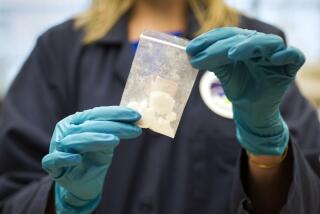Potent New ‘Designer Drug’ Seized in Federal Raid on Simi Valley Lab
- Share via
Federal narcotics agents Wednesday night raided a clandestine laboratory in a Simi Valley home and seized an experimental batch of a new, highly potent “designer drug” that was believed headed for the illicit market on a large scale for the first time.
Agents said the lab’s owner planned to manufacturer $16 million dollars worth of PEPAP, a synthetic heroin substitute that is 36 times more powerful than pure heroin.
The laboratory was operated in a home on Windwillow Way that is owned by Paul Ono, described by federal agents as the head of a nationwide heroin distribution network who was previously convicted of smuggling and selling heroin.
Ono, 43, was arrested in Los Angeles on a federal arrest warrant. Jailed with him was a Thai national, Pichate Chungsurut, 30, who was at Ono’s apartment. Agents said they found $350,000 in cash at the location along with small quantities of heroin. An elderly couple, Eleanor and Ben Shaw, both in their 60s, were arrested on federal warrants at the Simi Valley home.
According to an affidavit filed in support of a search warrant, Ono told a DEA informant in June that he had the chemicals and equipment necessary to produce an initial batch of PEPAP.
A DEA spokesman said undercover agents arranged the raid on the Ventura County home after a two-month investigation.
PEPAP was developed illegally four years ago as a substitute for another synthetic heroin substitute, MPPP, which was causing neuro-degenerative diseases with symptoms similar to Parkinson’s disease.
Experimental Batch
According to investigators, the Simi Valley lab was preparing an experimental batch of 60 grams, about 2 ounces, which when diluted would have produced about 80 kilos of dosage units. DEA Agent Ralph Lochridge said Ono planned to produce 600 kilos of undiluted PEPAP, enough to manufacture literally billions of dosage units with an estimated street value of $16 million. Ono “was going to market a great portion of it here in Los Angeles, with the rest to be distributed through a nationwide system he had already set up,” Lochridge said.
Ono believed he could initially capture 25% of the heroin market in Los Angeles, Lochridge said.
Drugs like PEPAP and MPPP are known as designer drugs because of the way they are made: taking the formula of a controlled narcotic and changing it slightly. Because authorities have been required to specify the makeup of drugs they want declared illegal, these designer drugs--in effect, the chemical cousins of illegal drugs--fell out of reach of the law until 1986, when Congress banned them.
Immediate Effect
Under the Controlled Substances Act, persons convicted of producing or distributing designer drugs now face a 15-year prison sentence and a $250,000 fine.
Lochridge said PEPAP causes an immediate effect that includes a heroin-like euphoria “but with a more dreamlike or spacey sensation typical of PCP. There’s a disorientation, visual illusion, auditory hallucinations and the blurring of vision.”
Although it was developed as an alternative to MPPP, the drug appears to produce similar undesireable side effects by selectively killing brain cells, Lochridge said.
Because such drugs are made in extremely concentrated forms, and because quality control is not the hallmark of designer-drug manufacturers, users are exposed to unusually high risks.
“This stuff is super-deadly,” Lochridge said. “It is so potent in its pure form that even fumes can kill. . . . It is hard to dilute down to useable strength.”
Started in 1979
One ounce of pure PEPAP can produce 20,000 dosage units and make a profit of about $200,000, investigators said.
PEPAP is the latest in a series of synthetic narcotics that have been substituted for heroin. This wave began in 1979 when a derivative of the medically used anesthetic-analgesic fentanyl hit the streets in California and began being sold misleadingly as “China White,” the street name for heroin from Southeast Asia.
The term “designer drug” hit the national vocabulary in 1985 when the federal government banned MDMA, a speed-related drug known as “Ecstasy.” Designer drugs first appeared in the late 1960s, and chemical variants of methaqualone, PCP and amphetamine have surfaced in the last decade.
Scores of deaths, most of them in California, have been directly linked to fentanyl-related designer drugs, and experts say because the synthetic is extremely difficult to detect in body fluids many more such deaths may have gone undetected.
More to Read
Sign up for Essential California
The most important California stories and recommendations in your inbox every morning.
You may occasionally receive promotional content from the Los Angeles Times.













